And did I like the The Battle Ground Project currently on display at the Textile museum?
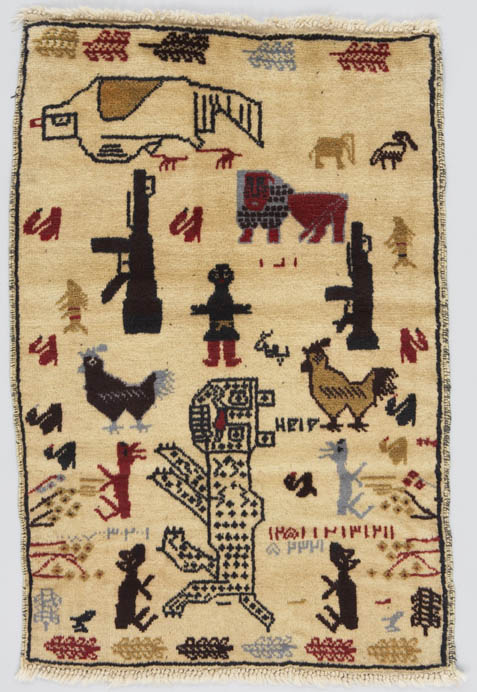
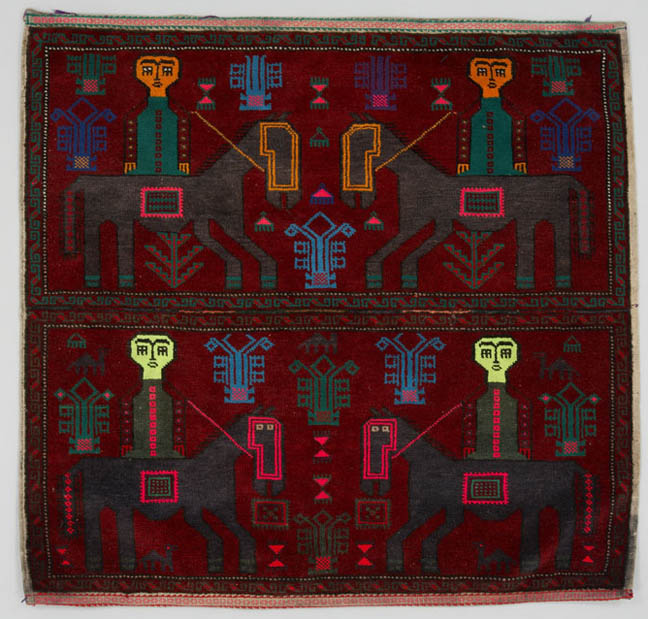
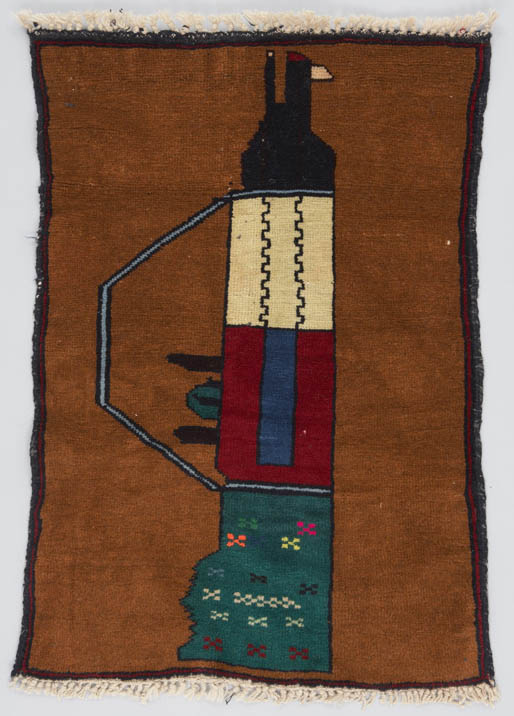
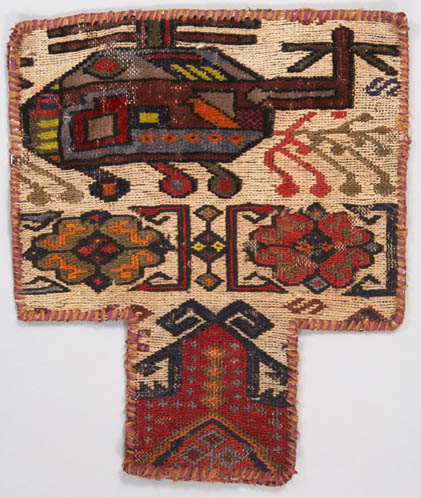
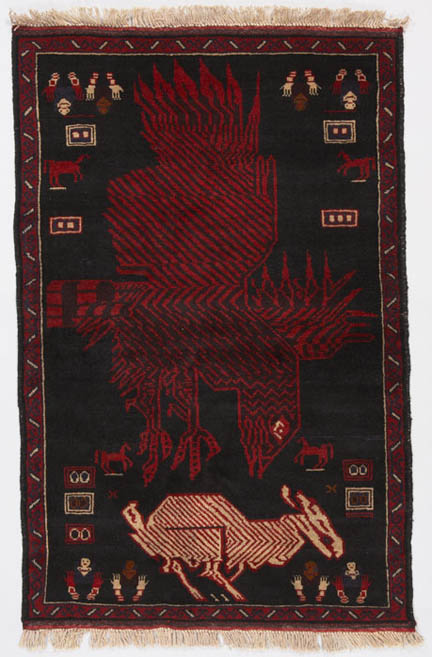
Yes, I'd say so. These images and more have been catalogued on the Textile Museum's site.
It also should be pointed out that this exhibition is sponsored by the National Post, the same newspaper that recently published an article by one of their resident retards (or maybe she was a freelance moron) that called for the ending of government funding for arts & culture, a bit disingenuous of them since they are happy to reap the tax breaks from their sponsorship of a cultural event such as this.
Perhaps it's money well spent in their minds because the Related Programs and Events include:
Talk: Dogs in War
Cinnamon was a military camp mascot on a US Military Base in Afghanistan. Just a puppy, she had found her way into the hearts of many of the service men and women stationed there. One in particular, LCDR Mark Feffer worried for her future when most of the troops who cared for her were due to rotate out of the region. Who would care for her then? Christine Sullivan founded New Hope for Animals with her brother Mark Feffer to raise money for animals in need. She is the author of 44 Days Out Of Kandahar: The Amazing Journey of a Missing Military Puppy and the Desperate Search to Find Her.
I love puppies, but this won't work, war isn't cute. (and those pesky arms-length arts juries would probably fund some crabby lefty artist who doesn't think war is cute either)
I noticed that doggie thing when I was combing their site to see if there was any credit to any of the people who'd made any of the rugs. Seems like that info is much harder to get than the rug. This excerpt from Macleans magazine quotes Max Allen, curator at Textile Museum and owner of the rugs.
And although the rugs were made in Afghanistan or by Afghan refugees in Iran and Pakistan, Allen cannot answer questions as to precisely who, where or when.
"The supply chain is long and complicated," said Allen, who plans to donate the rugs to the museum.
"A woman makes a rug and gives it to her husband who in turn gives it to his brother-in-law who knows a trader who's coming through the area and the trader has a friend in Pakistan who is a rug wholesaler who sells the rug to a dealer in Miami who puts it on the Internet and it ends up in the museum. And you try to trace that backwards and every step of the way the person you talk to has either some interest in concealing the source or doesn't know."
I think that identification issue would apply to a lot of the older artefacts in the Textile museum. Though I imagine that if you were a curator or archivist, there is nothing you'd want to know more, (they're pros and they love their collection). A collector from outside might not be so rigorous, and in the case of the more recent pieces that were made by an expat community in the US, you have to wonder.
well, yeah. It's the exotic artefact-ness of the whole thing that irks me a tiny bit, combined with the faint whiff of cultural voyeurism, combined with the weird circularity of the situation. We go into Afghanistan with an arsenal, Afghans incorporate weaponry into their imagery, we buy the rugs they make. I do know that this practice predates our involvment in Afghanistan, but still. That said, I'm really looking forward to the show.
I can easily follow the second part of your statement. I have more problems with the first part and how 'exotic artefact-ness' & 'cultural voyeurism' are defined. Is it because the context is a war?
naw, more because the context is a museum, and historically museum artefacts have been acquired and displayed as exotic treasures from other lands. The cultural voyeurism bit is more contemporary, a similar avarice for otherness, but maybe taking place in forums like boing boing rather than the hallowed museum halls. I don't want to claim that this is the only thing going on...but it does worry me a bit.
I like otherness.
i wonder if the afghans "incorporate weaponry into their imagery" so so because they know that it sells to naive westerners looking for an aestheticsed souveiner.
Eventually yes. But keep in mind that they were using this war imagery during the Soviet occupation as well. Not many sales opportunities then.
I like otherness too! I still find these rugs truly astounding. And if I saw a t-shirt with one of these rug designs I'd want it. But I wouldn't buy it. Maybe I would buy it. arg.
Traditionally these prayer rugs and carpets were created to commemorate individual battles, the difference is that these carpets now have been hybridized with western weaponry. Of course that makes them extraordinary to us, it turns the benign idea of cute ethno-crafts on its head. It's a response to cataclysmic events that we can directly understand because we recognise the weapons.
A site about the recent history of these rugs. (via Schwarz)
It just occurred to me that I didn't really take into account the political ambiguousness of the a lot of the pictorials on these rugs. Anonymity may be a way for some of the artists to protect themselves..
I've got a shiny little snack bag of "M-16 Watermelon Seeds," that I bought in Laos. Picture of crossed guns.
"it turns the benign idea of cute ethno-crafts on its head" ...okay, yes that is true. And I like that a lot.
I've heard from people, who've traveled to Vietnam, that U.S. army memorabilia is a big seller for the tourist trade. (everyone gets to feel like they did a tour of duty in the war with the best soundtrack ever, which doesn't mean I wouldn't go or find that stuff fascinating) b/t/w When were you in Laos?
One problem with the show as a whole is that the political ambiguousness of the rugs get tipped towards an ideology with the inclusion of the military patches in the exhibition and the small room with the videos of Canadian soldiers in Afghanistan.
And of course this is where you might start to feel compromised, the rugs are amazing, I think people should see them, but I'm not willing to congratulate the N.P. for their sponsorship or hold up this instance as any sort of ideal model of partnership between partially public funded institutions and business.
I like the discernment in your distinctions, L.M.
there is a big problem right now, among collectors of vietnam memorbillia, between zippos made in the 70s for soilders, and zippos made in the last decade for tourists, they are virtually indistengishable.
Yup, I've read that there's more zippos out there than were ever manufactured during that era. Sort of like shards of the True Cross.
The skulls of St. Peter, as a boy and as a man.
who wrote the line: if you put all of the shards of the true cross together, you get enough wood for a split level ranch?
The John Scott paintings in the post above remind me of the little scribblings of aircraft and weaponry that boys in my public school doodled all over their notebooks. I guess wartime was "our" turn to be preoccupied with weapons. The Korean war was on when I was in grade two (we had a scheduled time every day to knit afghan squares). The doodling habit persisted, because by the time we were in grade seven there was a board of education directive (or so our teacher claimed) that all human figures in our art class drawings had to be a minimum of eleven inches high. The teacher walked up and down the aisles with a ruler, and any figures that didn't measure up were tossed into the garbage.
Any excuse to post the, very relevent to this discussion, work by John Scott
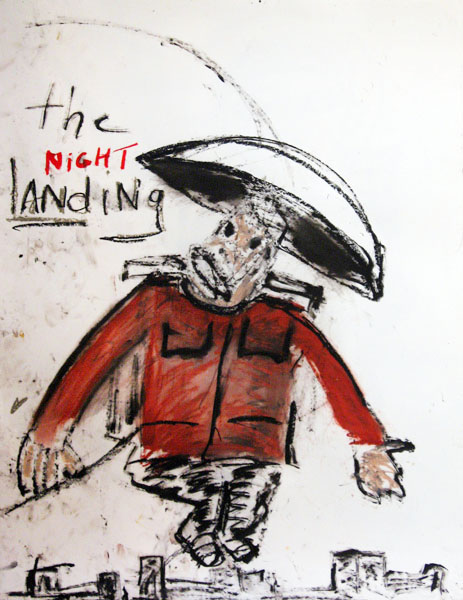
Night Landing
R.M. Vaughan reviews Battleground in the May 3rd Globe & mail:
Which leads back to the myriad of ethical questions the viewer must confront once the initial wonder dissipates. Do these works propagandize violence, or merely record it? Who are the images and messages in the rugs for - an Afghan audience or the guilt-ridden Western buyer? And, if the latter, does the ambiguous treatment of conflict in most of the rugs (few of the works collected here make outright calls for peace, but equally few can be regarded as battle cries) leave the Western viewer in the ugly position of voyeur?
Furthermore, would we apply similar ethical dilemmas to other exhibitions of art, or do we do so in this case because we in the West are implicated in the continuing violence, and/or because Afghanistan is topical? And, finally, do these questions ever apply to art? Nobody, after all, wonders whether it is ethical to gaze adoringly at Goya's war paintings.
|
And did I like the The Battle Ground Project currently on display at the Textile museum?
Yes, I'd say so. These images and more have been catalogued on the Textile Museum's site.
It also should be pointed out that this exhibition is sponsored by the National Post, the same newspaper that recently published an article by one of their resident retards (or maybe she was a freelance moron) that called for the ending of government funding for arts & culture, a bit disingenuous of them since they are happy to reap the tax breaks from their sponsorship of a cultural event such as this.
Perhaps it's money well spent in their minds because the Related Programs and Events include: I love puppies, but this won't work, war isn't cute. (and those pesky arms-length arts juries would probably fund some crabby lefty artist who doesn't think war is cute either)
- L.M. 4-24-2008 6:45 am
I noticed that doggie thing when I was combing their site to see if there was any credit to any of the people who'd made any of the rugs. Seems like that info is much harder to get than the rug. This excerpt from Macleans magazine quotes Max Allen, curator at Textile Museum and owner of the rugs.
- sally mckay 4-24-2008 6:32 pm
I think that identification issue would apply to a lot of the older artefacts in the Textile museum. Though I imagine that if you were a curator or archivist, there is nothing you'd want to know more, (they're pros and they love their collection). A collector from outside might not be so rigorous, and in the case of the more recent pieces that were made by an expat community in the US, you have to wonder.
- L.M. 4-24-2008 8:07 pm
well, yeah. It's the exotic artefact-ness of the whole thing that irks me a tiny bit, combined with the faint whiff of cultural voyeurism, combined with the weird circularity of the situation. We go into Afghanistan with an arsenal, Afghans incorporate weaponry into their imagery, we buy the rugs they make. I do know that this practice predates our involvment in Afghanistan, but still. That said, I'm really looking forward to the show.
- sally mckay 4-24-2008 8:46 pm
I can easily follow the second part of your statement. I have more problems with the first part and how 'exotic artefact-ness' & 'cultural voyeurism' are defined. Is it because the context is a war?
- L.M. 4-24-2008 9:15 pm
naw, more because the context is a museum, and historically museum artefacts have been acquired and displayed as exotic treasures from other lands. The cultural voyeurism bit is more contemporary, a similar avarice for otherness, but maybe taking place in forums like boing boing rather than the hallowed museum halls. I don't want to claim that this is the only thing going on...but it does worry me a bit.
- sally mckay 4-24-2008 10:56 pm
I like otherness.
- L.M. 4-25-2008 8:01 am
i wonder if the afghans "incorporate weaponry into their imagery" so so because they know that it sells to naive westerners looking for an aestheticsed souveiner.
- anthony (guest) 4-25-2008 1:20 pm
Eventually yes. But keep in mind that they were using this war imagery during the Soviet occupation as well. Not many sales opportunities then.
- L.M. 4-25-2008 9:49 pm
I like otherness too! I still find these rugs truly astounding. And if I saw a t-shirt with one of these rug designs I'd want it. But I wouldn't buy it. Maybe I would buy it. arg.
- sally mckay 4-25-2008 10:09 pm
Traditionally these prayer rugs and carpets were created to commemorate individual battles, the difference is that these carpets now have been hybridized with western weaponry. Of course that makes them extraordinary to us, it turns the benign idea of cute ethno-crafts on its head. It's a response to cataclysmic events that we can directly understand because we recognise the weapons.
A site about the recent history of these rugs. (via Schwarz)
- L.M. 4-25-2008 10:43 pm
It just occurred to me that I didn't really take into account the political ambiguousness of the a lot of the pictorials on these rugs. Anonymity may be a way for some of the artists to protect themselves..
- L.M. 4-26-2008 12:42 am
I've got a shiny little snack bag of "M-16 Watermelon Seeds," that I bought in Laos. Picture of crossed guns.
- M.Jean 4-26-2008 1:00 am
"it turns the benign idea of cute ethno-crafts on its head" ...okay, yes that is true. And I like that a lot.
- sally mckay 4-26-2008 1:02 am
I've heard from people, who've traveled to Vietnam, that U.S. army memorabilia is a big seller for the tourist trade. (everyone gets to feel like they did a tour of duty in the war with the best soundtrack ever, which doesn't mean I wouldn't go or find that stuff fascinating) b/t/w When were you in Laos?
One problem with the show as a whole is that the political ambiguousness of the rugs get tipped towards an ideology with the inclusion of the military patches in the exhibition and the small room with the videos of Canadian soldiers in Afghanistan.
- L.M. 4-26-2008 1:43 am
And of course this is where you might start to feel compromised, the rugs are amazing, I think people should see them, but I'm not willing to congratulate the N.P. for their sponsorship or hold up this instance as any sort of ideal model of partnership between partially public funded institutions and business.
- L.M. 4-26-2008 1:49 am
I like the discernment in your distinctions, L.M.
- sally mckay 4-26-2008 1:52 am
there is a big problem right now, among collectors of vietnam memorbillia, between zippos made in the 70s for soilders, and zippos made in the last decade for tourists, they are virtually indistengishable.
- anthony (guest) 4-26-2008 4:37 am
Yup, I've read that there's more zippos out there than were ever manufactured during that era. Sort of like shards of the True Cross.
- L.M. 4-26-2008 5:17 am
The skulls of St. Peter, as a boy and as a man.
- M.Jean 4-26-2008 5:48 am
who wrote the line: if you put all of the shards of the true cross together, you get enough wood for a split level ranch?
- anthony (guest) 4-26-2008 3:19 pm
The John Scott paintings in the post above remind me of the little scribblings of aircraft and weaponry that boys in my public school doodled all over their notebooks. I guess wartime was "our" turn to be preoccupied with weapons. The Korean war was on when I was in grade two (we had a scheduled time every day to knit afghan squares). The doodling habit persisted, because by the time we were in grade seven there was a board of education directive (or so our teacher claimed) that all human figures in our art class drawings had to be a minimum of eleven inches high. The teacher walked up and down the aisles with a ruler, and any figures that didn't measure up were tossed into the garbage.
- M.Jean 4-28-2008 4:55 pm
Any excuse to post the, very relevent to this discussion, work by John Scott

Night Landing
- L.M. 4-28-2008 10:03 pm
R.M. Vaughan reviews Battleground in the May 3rd Globe & mail:
- L.M. 5-04-2008 7:26 am